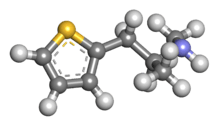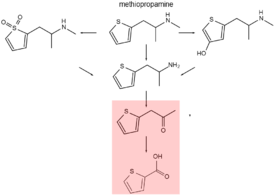Methiopropamine
 | |
 | |
| Clinical data | |
|---|---|
| ATC code | N06AA |
| Legal status | |
| Legal status |
|
| Identifiers | |
| |
| Synonyms | MPA; Methiopropamine; Methedrene; Syndrax |
| CAS Number |
801156-47-8 7464-94-0 (hydrochloride) |
| PubChem (CID) | 436156 |
| ChemSpider |
385727 |
| UNII |
64ON2ETH7I |
| Chemical and physical data | |
| Formula | C8H13NS |
| Molar mass | 155.261 g/mol |
| 3D model (Jmol) | Interactive image |
| |
| |
| | |
Methiopropamine (MPA) is a thiophene ring-based structural analog of methamphetamine originally reported in 1942.[1] Chemically it is not a phenethylamine or amphetamine and is not their functional analog either. It originally appeared for public sale in the UK in December 2010 as a "research chemical" or "legal high", recently branded as Blow.[2] It has limited popularity as a recreational stimulant.[3]
Pharmacology
Methiopropamine functions as a selective norepinephrine-dopamine reuptake inhibitor that is approximately 1.85 times more selective for norepinephrine than dopamine. It is approximately one third as potent as dextroamphetamine as a norepinephrine reuptake inhibitor and one fifth as much as a dopamine reuptake inhibitor. It displays negligible activity as a serotonin reuptake inhibitor.[4][5]
Metabolism

For N-alkyl amphetamines, deamination and N-dealkylation are the major elimination pathways and renal excretion is a minor one.[6] Methiopropamine is metabolized into active thiopropamine, 4-hydroxymethiopropamine and thiophene S-oxides.[7][8] These N-demethylated metabolites are further deaminated by the cytochrome P450 enzyme CYP2C19 in the liver transforming them into inactive 1-(thiophen-2-yl)-2-propan-2-one which can be seen as a phenylacetone derivative.[9][10]
Thiophene-2-carboxylic acid is the final major metabolic product. It is very hydrophilic and is excreted in urine. Methiopropamine and especially thiopropamine are also excreted renally, unchanged.
Synthesis
There is a four-step synthesis of methiopropamine. It begins with (thiophen-2-yl)magnesium bromide, which is reacted with propylene oxide, yielding 1-(thiophen-2-yl)-2-hydroxypropane which is reacted with phosphorus tribromide, yielding 1-(thiophen-2-yl)-2-bromopropane which is finally reacted with methylamine, yielding 1-(thiophen-2-yl)-2-methylaminopropane.[11]

Legal status
China
As of October 2015 MPA is a controlled substance in China.[12]
Finland
Methiopropamine is illegal in Finland.
Germany
Methiopropamine is explicitly illegal in Germany.
United Kingdom
Following the ban on ethylphenidate authorities noticed an increase in methiopropamine use by injecting users. The ACMD suggested it be banned on 18 November 2015[13] as it had similar effects to ethylphenidate. The government enacted a temporary drug control order a week later which came into force on 27 November 2015.[14] Though ordinarily the TCDO would only last 1 year, the ACMD reported that since its invocation prevalence of MPA had significantly decreased, and that it had been challenging to collect information about the drug. As a result of this, they requested that the TCDO be extended a further year.[15]
United States
Methiopropamine is not scheduled at the federal level in the United States.[16]
Florida
Methiopropamine is a Schedule I controlled substance in the state of Florida making it illegal to buy, sell, or possess in Florida.[17]
See also
- α-Pyrrolidinopentiothiophenone (α-PVT)
- Thiopropamine, demethylated counterpart
- Propylhexedrine, another ring substituted stimulant used as over-the-counter decongestant
- Thiothinone
References
- ↑ Blicke, F. F.; Burckhalter, J. H. (March 1942). "α-Thienylaminoalkanes". Journal of the American Chemical Society. 64 (3): 477–80. doi:10.1021/ja01255a001.
- ↑ Angelov, D; O'Brien, J; Kavanagh, P (March 2013). "The syntheses of 1-(2-thienyl)-2-(methylamino) propane (methiopropamine) and its 3-thienyl isomer for use as reference standards". Drug testing and analysis. 5 (3): 145–9. doi:10.1002/dta.298. PMID 21770051.
- ↑ Methiopropamine Thread at UKChemicalResearch.org
- ↑ Iversen, L.; Gibbons, S.; Treble, R.; Setola, V.; Huang, X. P.; Roth, B. L. (January 2013). "Neurochemical profiles of some novel psychoactive substances". European Journal of Pharmacology. 700 (1-3): 147–151. doi:10.1016/j.ejphar.2012.12.006. PMC 3582025
 . PMID 23261499.
. PMID 23261499. - ↑ Hyung Shin Yoon, Wen Ting Cai, Young Hun Lee, Kyung Tae Park, Yong Sup Lee, Jeong-Hoon Kim (2016). "The expression of methiopropamine-induced locomotor sensitization requires dopamine D2, but not D1, receptor activation in the rat". Behavioural Brain Research. doi:10.1016/j.bbr.2016.05.060. PMID 27265782.
- ↑ Vree, T.B.; Gorgels, J.P.M.C.; Muskens, A.Th.J.M.; Van Rossum, J.M. (September 1971). "Deuterium isotope effects in the metabolism of n-alkylsubstituted amphetamines in man". Clinica Chimica Acta. 34 (2): 333–44. doi:10.1016/0009-8981(71)90187-2. PMID 5113570.
- ↑ Treiber, Alexander; Dansette, Patrick M.; El Amri, Hamid; Girault, Jean-Pierre; Ginderow, Daria; Mornon, Jean-Paul; Mansuy, Daniel (1997). "Chemical and Biological Oxidation of Thiophene: Preparation and Complete Characterization of Thiophene S-Oxide Dimers and Evidence for Thiophene S-Oxide as an Intermediate in Thiophene Metabolism in Vivo and in Vitro". Journal of the American Chemical Society. 119 (7): 1565–71. doi:10.1021/ja962466g.
- ↑ Dansette, P.M.; Thang, Do Cao; Mansuy, H. El Amri D.; Mansuy, D (August 1992). "Evidence for thiophene-s-oxide as a primary reactive metabolite of thiophene in vivo: Formation of a dihydrothiophene sulfoxide mercapturic acid". Biochemical and Biophysical Research Communications. 186 (3): 1624–30. doi:10.1016/S0006-291X(05)81594-3. PMID 1510686.
- ↑ Yamada, Hideyuki; Shiiyama, Sachiko; Soejimaohkuma, Toyomi; Honda, Shin-Ichiro; Kumagai, Yoshito; Cho, Arthur K.; Oguri, Kazuta; Yoshimura, Hidetoshi (February 1997). "Deamination of amphetamines by cytochromes P450: Studies on substrate specificity and regioselectivity with microsomes and purified CYP2C subfamily isozymes". The Journal of Toxicological Sciences. 22 (1): 65–73. doi:10.2131/jts.22.65. PMID 9076658.
- ↑ Welter, J.; Meyer, M.R.; Wolf, E.U.; Weinmann, W.; Kavanaugh, P.; Maurer, H.H. (April 2013). "2-methiopropamine, a thiophene analogue of methamphetamine: studies on its metabolism and detectability in the rat and human using GC-MS and LC-(HR)-MS techniques". Analytical and Bioanalytical Chemistry. 405 (10): 3125–3135. doi:10.1007/s00216-013-6741-4. PMID 23361230.
- ↑ Casale, John F.; Hays, Patrick A. (2011). "Methiopropamine: An Analytical Profile" (PDF). Microgram Journal. 8 (2): 53–7.
- ↑ "关于印发《非药用类麻醉药品和精神药品列管办法》的通知" (in Chinese). China Food and Drug Administration. 27 September 2015. Retrieved 1 October 2015.
- ↑ Advisory Council on the Misuse of Drugs (25 November 2015). "Methiopropamine (MPA): A review of the evidence of use and harm" (pdf). UK Home Office. Retrieved 27 November 2015.
- ↑ "The Misuse of Drugs Act 1971 (Temporary Class Drug) (No. 3) Order 2015". UK Government. 23 November 2015.
- ↑ "Re: Temporary Class Drug Order on methiopropamine". 2016. Retrieved 2016-11-28.
- ↑ 21 CFR — SCHEDULES OF CONTROLLED SUBSTANCES §1308.11 Schedule I.
- ↑ Florida Statutes - Chapter 893 - DRUG ABUSE PREVENTION AND CONTROL